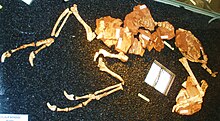
Back بالور (زاحف) Arabic Balaur bondoc Catalan Balaur bondoc Czech Balaur German Balaur bondoc Greek Balaur bondoc Spanish بالائور (دایناسور) Persian Balaur (dinosaure) French באלאור (דינוזאור) HE Balaur bondoc Hungarian
| Balaur bondoc Temporal range: Late Cretaceous,
| |
|---|---|

| |
| Holotype specimen | |
| Scientific classification | |
| Domain: | Eukaryota |
| Kingdom: | Animalia |
| Phylum: | Chordata |
| Clade: | Dinosauria |
| Clade: | Saurischia |
| Clade: | Theropoda |
| Clade: | Paraves |
| Genus: | †Balaur Csiki et al., 2010 |
| Species: | †B. bondoc
|
| Binomial name | |
| †Balaur bondoc Csiki et al., 2010
| |
Balaur is a genus of theropod dinosaur from the late Cretaceous period, in what is now Romania. It is the type species of the monotypic genus Balaur, after the balaur (Romanian pronunciation: [baˈla.ur][1]), a dragon of Romanian folklore. The specific name bondoc (Romanian pronunciation: [bonˈdok][2]) means "stocky", so Balaur bondoc means "stocky dragon" in Romanian. This name refers to the greater musculature that Balaur had compared to its relatives. The genus, which was first described by scientists in August 2010, is known from two partial skeletons (including the type specimen). Some researchers suggest that the taxon might represent a junior synonym of Elopteryx.
Fossils of Balaur were found in the Densuș-Ciula and Sebeș Formations of Cretaceous Romania which correspond to Hațeg Island, a subtropical island[3] in the European archipelago of the Tethys sea approximately 70 million years ago. Hațeg Island is commonly referred to as the "Island of the Dwarf Dinosaurs" on account of the extensive fossil evidence that its native dinosaurs exhibited island syndrome, a collection of morphological, ecological, physiological and behavioural differences compared with their continental counterparts. Examples included island gigantism of Hatzegopteryx, island dwarfism of the titanosaur Magyarosaurus dacus, and a reduction in flight capacity in Balaur.
Balaur is currently believed to be a basal avialan, a group that includes modern birds, based on phylogenetic analysis, despite being previously grouped within the dromaeosaurid dinosaurs, a group which includes Velociraptor. This reduction in flight capacity is also seen in extant island birds including the ratites and insular barn owls[4] as well as the extinct moa of New Zealand[5] and the extinct dodo of Mauritius.
- ^ "Definitie: balaur | DEX online". Dexonline.ro. Retrieved 2010-09-25.
- ^ "Definitie: bondoc | DEX online". Dexonline.ro. Retrieved 2021-03-12.
- ^ Benton, Michael J.; Csiki, Zoltan; Grigorescu, Dan; Redelstorff, Ragna; Sander, P. Martin; Stein, Koen; Weishampel, David B. (15 July 2010). "Dinosaurs and the island rule: The dwarfed dinosaurs from Hațeg Island". Palaeogeography, Palaeoclimatology, Palaeoecology. European island faunas of the Late Cretaceous – The Hațeg Island. 293 (3–4): 438–454. Bibcode:2010PPP...293..438B. doi:10.1016/j.palaeo.2010.01.026.
- ^ Roulin, A.; Salamin, N. (19 April 2010). "Insularity and the evolution of melanism, sexual dichromatism and body size in the worldwide-distributed barn owl". Journal of Evolutionary Biology. 23 (5): 925–934. doi:10.1111/j.1420-9101.2010.01961.x. PMID 20298444. S2CID 20356466.
- ^ Worthy, T. H.; Scofield, R.P. (2012). "Twenty-first century advances in knowledge of the biology of moa (Aves: Dinornithiformes): a new morphological analysis and moa diagnoses revised". New Zealand Journal of Zoology. 39 (2): 87–153. doi:10.1080/03014223.2012.665060. S2CID 83768608.
© MMXXIII Rich X Search. We shall prevail. All rights reserved. Rich X Search